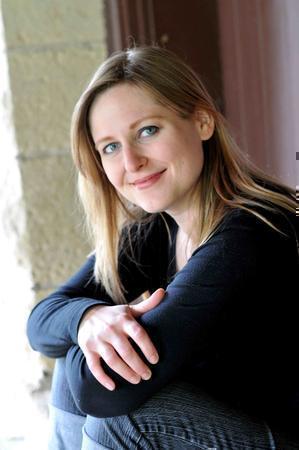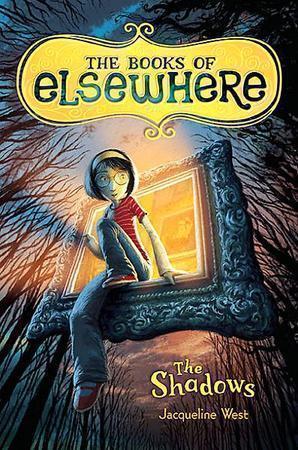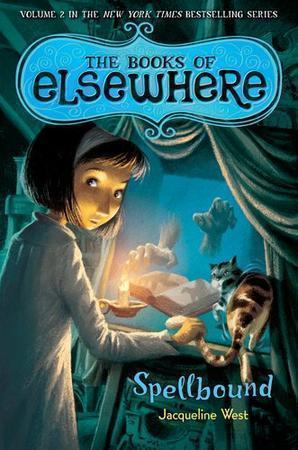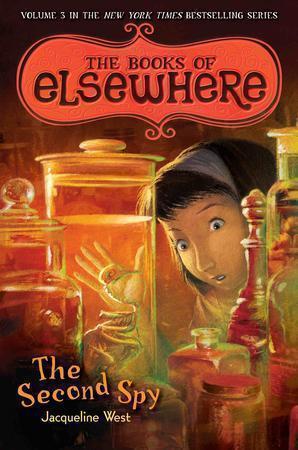 Jacqueline West is the author of The Books of Elsewhere series, including “The Shadows,” “Spellbound” and “The Second Spy.” Below is a complete transcript of her interview with Cracking the Cover.
Jacqueline West is the author of The Books of Elsewhere series, including “The Shadows,” “Spellbound” and “The Second Spy.” Below is a complete transcript of her interview with Cracking the Cover.
Have you always wanted to be a writer?
I’ve loved books since I was too young to read them to myself, but I didn’t grow up thinking I was going to be a writer. I thought of writers as brilliant, magical, larger-than-life beings who lived in places like London and Paris and Prince Edward Island, and I was a smallish, ordinary girl in Wisconsin. I was pretty sure that writing was outside my personal realm of possibility.
I spent a lot of time with stories, however – listening to them, reading them, acting them out, and finally making up some of my own. I started trying to get those stories out of my head and onto paper when I was eight or nine years old. Many years of practicing went by before I felt brave enough to show anyone the things I’d written, but by that time, I had written hundreds of poems and reams of stories, and I had learned a little bit about writing.
Once you did decide, how did you make that happen?
Even after all those years of practicing, I was afraid to call myself ‘a writer.’ I went to college for vocal music (with a minor in English), moved on to graduate school for voice, and finally realized that I didn’t actually want to be an opera singer–I wanted to spend all day, every day, talking about stories and language and poetry and plays. So I became a high school English teacher. It was during my second year of teaching that I found an agent and signed a contract for The Shadows, the first of The Books of Elsewhere, which I had been working on ever since those undergraduate voice-major days.
So I’m not sure I ever really decided I would be a writer. I just wrote a lot, and eventually, I became one.
 Why do you write for young people?
Why do you write for young people?
The Shadows was the first thing I had ever tried to write for young readers. It was a story that I wanted to tell, and it was something that I thought my younger self—and my two brothers—would have liked. When I finished it, I felt like I had finally put my feet into the right pair of shoes. Oh, I thought. So this is what I’m supposed to be doing.
Talking to kids who have read my books, and getting handwritten letters and crayon drawings and emails from young readers all over the world, is absolutely amazing. They are the most enthusiastic, open-minded, well-read audience. Honestly, anyone who doesn’t write for kids is missing out.
Where did the idea for The Books of Elsewhere come from?
It all started with the setting. There was a house in my hometown that I used to pass every day on the way to middle school. It was a once-grand Victorian home, but now the paint was peeling off of its walls, and its shady lawn was overgrown, and its windows were always dark. It was owned by a retired doctor who built small wind-powered machines, which were scattered all over his lawn; whenever the wind blew they would move and spin eerily. 11-year-old me would look at that house through the school bus windows and wonder, ‘What kind of people would live in a house that looks like that?’
Years later, when I started putting The Shadows down on paper, I wanted to use that house—or at least the idea of that house—as my starting point. I wanted to put a modern, mathematical, hyper-logical family in an old-fashioned, magical, haunted setting, and see what would happen. So I moved the Dunwoodys into the McMartin mansion and everything else grew from there.
Did you always know it would be a series?
No, I didn’t. I wrote The Shadows assuming that no one would want one book by me, let alone two or more, so I thought of it as a stand-alone story. The funny thing was, as soon as my agent and my editor brought up the possibility of a sequel, I realized that The Shadows could not have been the end of Olive’s story. Enemies were stopped, but not destroyed, mysteries were explored but not solved, and Morton was still stuck, parentless, in his painting. I can’t believe I was just going to leave him there, but apparently I was. (Sorry, Morton.)
 How many more books are planned?
How many more books are planned?
There will be five books in the series. I’m wrapping up revisions on Volume Four right now, and the end of the series is in sight. Well…it’s kind of a tiny smudge on the horizon right now, but I know that I’m getting closer.
Olive is an independent young woman. Is she based on any particular person?
Nope! She just showed up in my head—with that name, wearing her slightly dirty tennis shoes—and I knew exactly who she was. Sometimes she feels so real to me that I can imagine looking out my window and seeing her in the park across the street. She would be strolling along, reading a book and not watching where she was going, or crouching in the grass to collect smooth rocks to decorate with fingernail polish.
Bits of her personality probably do come from various kids I’ve known or taught over the years. Olive is shy and a little awkward with strangers, but she’s also polite and kind. She doesn’t have the talents that she wishes she had: She’s not a mathematical genius like her parents; she doesn’t have any magical powers or gifts; she’s not predestined to save the world. She’s just a thoughtful, creative, curious girl who is much, much braver than she thinks she is.
If you could walk inside a painting, what one would you choose?
Ooh… There are lots of paintings that would be fun to visit. I’d love to wander in Monet’s or Van Gogh’s worlds for a while, or slide around inside Salvador Dali’s canvases, playing with squishy clocks and bouncing on rubbery boulders. But if I had to choose just one painting, I think it would be something by the Wisconsin painter Andy Van Schyndle, who creates these creepy, funny, surreal, magical, gorgeous worlds. I’d probably go with Light My Way Home Little Acorn Lantern, as I’m not sure I’d be welcome in Where the Cows Go, and the centipede on the carousel in Forest Encounters makes my skin crawl. (You can see some samples at wagalabagala.com.)
I love the cats’ personalities. How have they developed?
While I was writing The Shadows, friends of mine owned cats that were actually named Horatio, Leopold, and Harvey, and I thought those names were simply too cool not to use. The book cats borrow a few traits from the real-world cats—the real Horatio is very dignified, with long, luxuriant fur; the real Harvey was a spastic ball of unpredictable energy. In the books, each cat is also a mirror of the part of the house that he guards. Leopold, in the basement, is large and dark, and is an old-fashioned soldierly gentleman of a cat. Horatio, on the main floors, is grand and vain and important (or at least he thinks he is) and often acts as the leader. Harvey is a lot like the attic: He’s this crazy jumble of oddities. As the story has grown, and Olive has gotten to know and love them, the cats have revealed some parts of themselves that are ordinarily hidden. In spite of his military bearing, Leopold can be quite a softy. Horatio feels serious guilt for everything the cats helped the McMartins to do. Behind his swashbuckling alter-egos, Harvey hides some genuine fears. They’ve become more complete and more complex, I think.
 Why do you think your books appeal to young readers?
Why do you think your books appeal to young readers?
I guess there are other young readers who liked the sorts of stories that I liked: Stories that are creepy but funny at the same time; stories that inject the real world with adventure and magic. I think—or at least I hope—that I haven’t forgotten what it felt like to be a kid, or to have a kid’s perspective on the world and its mysteries. Plus, there’s Harvey: a talking cat with multiple personalities and delusions of grandeur. They all really seem to like him.
Are you surprised by the success of your books?
Yes. All the time. Every day. Sometimes I imagine a bunch of official-looking people in black suits and dark sunglasses showing up at my front door. One of them tells me, ‘Excuse us, Ms. West, but it appears that you have gotten to live the life that was intended for someone far more deserving.’ And then they take all of my books and my laptop and march back out again.
Looking back, how has your writing evolved?
I started writing The Shadows when I was a college student. It took eight years for me to finish it, find an agent, work with an editor, and get the book published. By the time I started work on Volume Two: Spellbound, I was truly a different (and much older) person. The things that I learned from those intervening years of writing, and from teaching English, and from working with my amazing editor have all given me a much bigger set of tools than I had before. Writing still doesn’t feel easy—and really, I hope it never does—but I’ve learned how to adapt, to solve problems, to look at situations in a variety of ways.
Also, my typing has gotten a lot faster. And my handwriting has gotten a lot worse.
Do you have a book that resonated with you as child?
I loved books about imaginative, independent girls who lived a hundred years ago and who dreamt of becoming writers, like Anne of Green Gables, A Tree Grows in Brooklyn, and Little Women. I loved creepy/funny/strange books like the Bunnicula series, and Alice in Wonderland, and everything by Roald Dahl. And I loved books where a main character’s imagination transformed the world into something magical, like Winnie-the-Pooh, and Calvin and Hobbes, and later, Dandelion Wine.
What are you working on now?
Volume Four of The Books of Elsewhere is almost finished, and then I’ll embark on Volume Five. I’m also between revisions on a YA project which is very, very different from The Books of Elsewhere, and I’ve got two other book ideas that are waiting to be let out of the back of my brain.
I’m also trying to get my dog to stop losing his mind every time a UPS truck drives by, but my work on this project may never be done.
